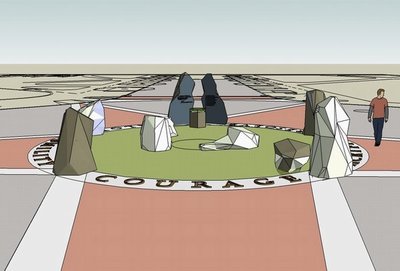August 20, 2009
Medal of Honor memorial to be constructed near WW I and WW II memorials
On the outside, the rock is plain and ordinary serpentine stone common to Washington State. Opened and polished, however, it gives off a glow, sort of like ordinary people courageous enough to do something extraordinary for their country.
The book stone, as it’s been called, will be a key part of a Medal of Honor monument, which is being constructed in the traffic circle south of Memorial Way. Dedication is scheduled for Nov. 10-11.
Funded by private contributions, the monument recognizes eight UW alumni who have received the award, the nation’s highest for military valor. The UW has more such alumni than any university except the service academies.
“The memorial will be a permanent, powerful reminder of the extraordinary things that can happen when ordinary people take action,” UW President Mark Emmert said.
It will be located between two related venues: Memorial Way and the University flagpole. Memorial Way begins at the 17th Avenue N.E. entrance to campus and is lined with 58 sycamore trees honoring UW students and faculty who died in World War I. South of it, just beyond the traffic circle where the Medal of Honor memorial will be, the flagpole bears names of UW students, alumni, faculty and staff who gave their lives in World War II.
Heidi Wastweet, a Seattle sculptor, and Mike Magrath, a UW instructor in sculpture and public art, collaborated on the Medal of Honor design, having worked successfully on the Nobel plaques in Suzzallo Library.
The design consists of a five-point star anchored by rock sculpture in a center circle. At the north point of the circle is the book stone, a rock that had sat unnoticed outside the UW art building for many years.
The stone will include each recipient’s name, rank, award year and years at UW. A shorter column in front of the book stone will feature the face of Minerva, goddess of both war and wisdom, who’s also pictured on the Medal of Honor. “We want to inspire students who walk around and through the memorial,” Wastweet said. “We want them to think that if these alumni could do extraordinary feats, then they can, too.”
Near those rocks will be others, including one in the middle with bronze wording from the recipients’ Medal certificates. “We found that no image was as powerful the details of what those men did,” Wastweet said.
Since the Medal of Honor was first awarded in 1862, 3,465 U.S. soldiers have received it, 618 posthumously. The UW memorial grew out of a student senate motion that set aside a proposed memorial to UW alumnus Gregory “Pappy” Boyington,’34, a Marine fighter pilot who downed 28 enemy planes before the Japanese captured him and sent him to a prisoner of war camp. The senate favored a memorial recognizing all UW Medal recipients.
The seven UW alumni besides Boyington who have received the Medal are:
- Deming Bronson: Wounded by a hand grenade and a bullet, Bronson nevertheless led his unit in capturing enemy positions near Eclisfontaine, France in 1918. At the UW, Bronson was a forestry major and played Husky football from 1912 to 1916.
- Robert E. Galer: As a Marine Corps major in 1942, Galer shot down 11 enemy aircraft in 29 days. He himself was shot down four times during World War II and the Korean War. Galer retired as a brigadier general in 1957.
- Bruce Crandall: On November 14, 1965, while under extreme fire in Viet Nam, Crandall nevertheless landed his helicopter and supervised the loading of seriously wounded soldiers. It inspired other helicopter pilots to do the same.
- John D. “Bud” Hawk: Hawk was wounded in France on August 20, 1944. His medal citation says that while wounded, he was largely responsible for crushing two German attempts to escape from the Falaise Pocket and for taking more than 500 prisoners.
- Robert Leisy: In Phuoc Long province during the Viet Nam war, North Vietnamese soldiers attacked Leisy’s unit, far outnumbering them. Leisy shielded his men from a rocket grenade attack and died of wounds Dec. 2, 1969. He was 24.
- William Kenzo Nakamura: Twice within a short period in 1944, Nakamura singlehandedly attacked German machine gunners in Italy so his platoon could be freed from pinned-down positions. During his second effort, Nakamura was killed.
- Archie Van Winkle: In November 1950, Van Winkle led a charge through Korean bullet fire. One bullet shattered his arm, and a hand grenade exploded against his chest. Refusing to be evacuated, Van Winkle continued shouting orders and encouragement to his men. His platoon eventually repulsed a fanatical enemy attack.
The $152,000 memorial and the dedication ceremony have been paid for with private contributions and a match program with TriWest Healthcare Alliance and the Bruce and Jolene McCaw Family Foundation.
“The monument honors those who fought not for medals but to save the lives of their comrades. Their courage and selflessness reflects the American spirit,” said David J. McIntyre Jr., president and chief executive officer of TriWest.
For more information about the memorial, click here.


